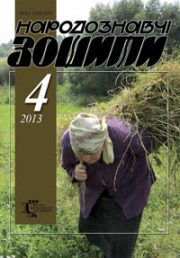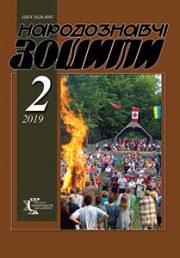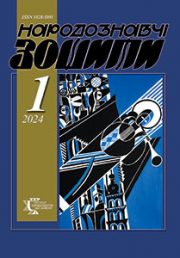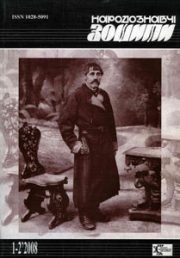The Ethnology Notebooks. 2020. № 1 (151), 60—92
UDK745.52:39](477.8+474.5)
DOI https://doi.org/10.15407/nz2020.01.060
WESTERN UKRAINIAN AND LITHUANIAN BEDSPREADS: DECOR ETHNO-ARTISTIC TRADITION PARALLELS
NYKORAK Оlena
ORCID ID: https://orcid.org/0000-0003-0887-8929
doctor in Arts, professor,
Leading Researcher
Ethnology Institute National Academy of Sciences of Ukraine,
Folk Art Department
15, Svoboda Avenue, 79000, Lviv, Ukraine
Contacts: e-mail: olenanykorak@gmail.com
KUTSYR Tetiana
ORCID ID: https://orcid.org/0000-0002-6522-0640
candidate of arts (Ph D)
Junior Researcher
Ethnology Institute National Academy of Sciences of Ukraine,
Folk Art Department
15, Svoboda Avenue, 79000, Lviv, Ukraine
Contacts: e-mail: sonechko_29@ukr.net
KUMPIKAITE Egle
PhD in Technical Sciences, associate professor
Kaunas University of Technology
Faculty of Mechanical Engineering and Design
Department of Production Engineering
56 Studentu str., LT-51424, Kaunas, Lithuania
Contacts: e-mail: egle.kumpikaite@ktu.lt
MILASIENE Daiva
PhD in Technical Sciences, associate professor
Kaunas University of Technology
Faculty of Mechanical Engineering and Design
Department of Production Engineering
56 Studentu str., LT-51424, Kaunas, Lithuania
Contacts: e-mail: daiva.milasiene@ktu.lt
RUKUIZIENE Zaneta
PhD in Materials Science, lecturer,
Kaunas University of Technology
Faculty of Mechanical Engineering and Design
Department of Production Engineering
56 Studentu str., LT-51424, Kaunas, Lithuania
Contacts: e-mail: zaneta.rukuiziene@ktu.lt
NENARTAVICIUTE Erika
senior officer
Open Air Museum of Lithuania in Rusiskes
Department of Everyday Life, Folk Trades and Crafts
2 L. Lekaviсiaus str., LT-56337
Rumsiskes, Kaisiadoriu district, Lithuania
Contacts: e-mail: erikanort@yahoo.com
Abstract. Introduction. The folk Western Ukrainian and Lithuanian bedspreads are studied base on the results of Ukrainian and Lithuanian interdisciplinary r&d project «Ornamentation of West Ukrainian and Lithuanian Folk Textile: Universal and Unique Parameters» in the paper. The lack of comparative analysis, the most noticeable decor features of Western Ukrainian and Lithuanian woven items, in particular the bedspreads, has defined the study relevance and novelty.
This paper purpose consists in identifying technical parameters, artistic and stylistic features of ethno-artistic traditions of Western Ukrainian and Lithuanian bedspreads’ decor.
Tradition bedspread of Western Ukraine and Lithuania are the study object and the subject is the common and distinctive features of their decor.
Comparative-historical method and art analysis are methodological basis of the work. They have permitted to reveal the characteristic features woven bedspreads of Ukrainian and Lithuanian studied territories at the end of the 19th — the first half of the 20th centuries.
There were three kinds of sources using in the research: scientific publication of Ukrainian and Lithuanian scholars in the field of traditional weaving; the items from studied museum collections at Lviv, Kolomyia, Kosiv, Ivano-Frankivsk, Krylos, Radyvyliv, Lutsk, Vilnius, Kaunas, Rumsiskės, Kretinga, Klaipėda; materials of long-term field authors’ researches in Ukraine and Lithuania.
Results. Ukrainian and Lithuanian different kinds of bedspreads as well as their regional and local originality of their structure, texture, motifs, ornament, variability of composition schemes and color palette are characterized in the paper. Unique and universal features of Ukrainian items` ornamentation from different historical and ethnographic regions of Western Ukraine and similar items from Lithuania are noted.
Western Ukrainian and Lithuanian bedspreads’ studying has testified the existence in these areas of numerous types of woven fabrics and their local variants. Comparative art analysis of Ukrainian and Lithuanian items’ decor has helped identify a number of common and distinctive artistic features, ethnic indication of originality and local identity. They are a significant component of the national artistic heritage of Ukraine and Lithuania.
Keywords: Western Ukraine, Lithuania, weaving, bedspread, ornament, composition, coloring.
Received 26.01.2020
REFERENCES
Hurhula, I. (1966). Folk Art of Ukrainian Western Region. Kyiv: Mystettsvo [in Ukrainian].
Hurhula, I. (1967). Modern Weaving and Embroidery of Bukovyna and Polissia. Folk Art and Ethnography, 4, 102—103 [in Ukrainian].
Sydorovych, S. (1979). Art Fabrics of UkrSSR Western Regions. Kyiv: Naukova Dumka [in Ukrainian].
Zakharchuk-Chuhai, R. (1983). Weaving. In Hoshko, Ju. Boikivshchyna. History and Ethnography Research (Pp. 139—141). Kyiv: Naukova Dumka [in Ukrainian].
Zakharchuk-Chuhai, R. (1993). Art Weaving. In Antonovych, Ie., Zakharchuk-Chuhai, R., Stankevych, M. Decorative and Applying Art (Pp. 29—33). Lviv: Svit [in Ukrainian].
Zakharchuk-Chuhai, R. (1993). Clothing, Adornment. In Antonovych, Ie., Zakharchuk-Chuhai, R., Stankevych, M. Decorative and Applying Art (Pp. 48—63). Lviv: Svit [in Ukrainian].
Zakharchuk-Chuhai, R. (1995). Folk Decorative Art. In S. Pavliuk, M. Hlushko (Eds.). Ukrainian Polissia. Historical and Ethnographic Research (Vol. 2). Ovruchchyna (Pp. 302—304). Lviv: NAS of Ukraine. Ethnology Institute [in Ukrainian].
Kara-Vasylieva, T. (1997). In Borysenko, V. Kholmshchyna and Pidliashshia: Historical and Ethnographic Research (Pp. 223—248). Kyiv: Rodovid [in Ukrainian].
Boriak, О. (1994). Weaving. In Artiukh, L. Podillia: Historical and Ethnographic Research (Pp. 484—497). Kyiv: Dolia Rodovid [in Ukrainian].
Sakhro, M. (1976). Hutsul`s Lizhnyk Making. Folk Art and Ethnography, 3, 53—58 [in Ukrainian].
Sakhro, M. (1978). Decorative and Applying Fabrics from Kolomyia Region. Folk Art and Ethnography, 4, 49—58 [in Ukrainian].
Nykorak, O. (1988). Modern Art Cloths of Ukrainian Carpathian Mountains. Kyiv: Naukova Dumka [in Ukrainian].
Nykorak, O. (2004). The Ukrainian Traditional Folk Cloths of XIX and XX cc. (Part I). Interior Cloths (Based on Materials from Ukrainian Western Regions). Lviv: Ethnology Institute of NAS of Ukraine [in Ukrainian].
Nykorak, O. (2010). Ukrainian Folk Ornamental Cloths: Comparative Characteristic. Notes Shevchenko Scientific Society (Vol. 259 (CCLIX). Labor Section of Ethnography and Folklore (Pp. 179—210). Lviv [in Ukrainian].
Oliinyk, O. (2017). The Folk Weaving of Pokuttia: Tradition and Modernity. The Ethnology Notebooks, 2 (134), 251—274. DOI: 10.15407/nz2017.02.251 [in Ukrainian].
Selivachov, M. (2005). Lexicon of Ukrainian Ornamentation (Iconography, Nomination, Styles, Typology). Kyiv: Ant [in Ukrainian].
Savoniakaite, V. (1998). Fabrics in Rural Culture: Lithuanian Geometric Patterns in the 19th and 20th Centuries. Vilnius: Alma littera [in Lithuanian].
Kudirka, J. (1984). The Lithuanians Territorial Peculiarities of Folk Art. In Originality of Folk Art (Pp. 95—102). Kaunas.
Kumpikaite, E., Tautkute-Stankuviene, I., & Kot, L. (2016). Double-layer Fabrics with Folk Motives. Experimental and Theoretical Study of Their Characteristics. Fibers and Textiles in Easten Europe, 6, 100—108. DOI: 10.5604/12303666.1221743.
Kumpikaite, E., Tautkute-Stankuviene, I., & Kot, L. (2016). Ornamentation of Lithuanian Ethnographic Home Textiles. Fibers and Textiles in Easten Europe, 5, 100—109. DOI: 10.5604/12303666.1215534.
Neniene, I., Kumpikaite, E., & Ragaisiene, A. (2013). Traditions and Inovations of yarns in Lithuanian Folk Fabrics (19th Century). Material Science, 2, 184—185. DOI: 10.5755/j01.ms.19.2.4436.
Cybulska, M. (2010). Reconstruction of Archaelogical Textiles. Fibres and Textiles in Eastern Europe, 18, 100—105.
Tallat–Kelpsaite–Niunkiene, G. (1988). Colours of Bedspreads. In Colour in Lithuanian Folk Art (Pp. 32—36). Vilnius: LTSR Kulturos ministerija, Mokslinės kulturos centras.
Novytska, M. (1948). On the Issue of Trypillian Culture Textile. In Archeology (Vol. 2, pp. 44—46). Kyiv [in Ukrainian].
Shcherban, A. (2007). Spinning and Weaving in the Inhabitans of the Ukrainian Left-Bank Forest-Steppe of the VII — the Beginning of the III Centuries BC (Based on Clay Items). Kyiv: Molod [in Ukrainian].
Mazuryk, Iu., & Ostapiuk, О. (2003). Two Fragments From the Archaeological Excavations of the Chronicle`s Ugrovsk. Volyn and Polissia Past and Present. Folk Culture is the way to Ourselves, 11, 102—104 [in Ukrainian].
Karger, M. (1957). Report on the Excavations of the Galicia-Volyn Expedition of the Material Culture History Institute of the USSR Academy of Sciences and the Leningrad State University in 1957. Scientific Archives of the Archeology Institute of the NAS of Ukraine. F.0. 1957 (Arc. 27) [in Russian].
Stankevych, M. (2003). To the Issue of Ukrainian Folk Art National Paradigms. The Ethnology Notebooks, 1—2, 176—179 [in Ukrainian].
Stankevych, M. (2004). Pattern or Ornament? (Terminological, Ontological View and More). In Stankevych, M. Art Authenticity (Pp. 155—170). Lviv [in Ukrainian].
Volkov, F. (1916). Ethnographic Features of Ukrainian People. In Volkov, F. The Ukrainian People in His Past and Present (Vol. 2, pp. 455—647) Sankt-Peterburg [in Russian].
Pavlutskyi, H. (1927). Ukrainian Ornament History. Kyiv: Ukrainian Academy of Science [in Ukrainian].
Tyshchenko, O. (1992). History of Decorative and Applying Art of the ХІІІ—XVIII cc. Kyiv: Lybid [in Ukrainian].
Musienko, P. (1969). Cloths. In M. Bazhan (Ed.) Ukrainian Art History (Vol. 4, b. 1, pp. 265—275). Kyiv [in Ukrainian].
Musienko, P. (1970). Cloths. In M. Bazhan (Ed.) Ukrainian Art History (Vol. 4, b. 1, pp. 320—328). Kyiv [in Ukrainian].
Butnic-Siverskyi, B. (1966). Ukrainian Soviet Folk Art. Kyiv [in Ukrainian].
Butnic-Siverskyi, B. (1970). Ukrainian Soviet Folk Art. 1941—1967. Kyiv [in Ukrainian].
Shukhevych, O. (1997). Hutsulshchyna. Reprint edition (Part 1—2). Verkhovyna: Hutsulshchyna [in Ukrainian].
Katunskis, J., Milasius, V., & Taylor, D. (2004). Software for Creation of a Database of Ornamentation of National Woven Fabrics. Fibres and Textiles in Eastern Europe, 12, 43—46.
Balcikonis, Iu., Glemzaite, M., Kairiukstyte-Jaciniene, H., & Mikenaite, A. (1957). Lithuanian Folk Art (Vol. 1). Vilnius: State Publishing Fiction House of the Lithuanian SSR [in Lithuanian].
Sichynskyi, V. (1936). Essays on the Ukrainian Industry History. Lviv [in Ukrainian].
MFAELL, АP-13704.
TORM, Т-3590.
TORM, Т-2289.
TORM, Т-4737.
MEAT, EP-71351.
MFAELL, AP-8374.
NML, NMT-1794.
MFAELL, AP-9488.
MFAELL, AP-488.
NML, NMT-1619.
MFAELL, AP-15692.
Horyn, H., Hrendysh, Ia., & Nykorak, O. (1987). Processing Weaving Raw Materials. In Arsenych, P. Hutsulshchyna. Historical and Ethnographic Research. Kyiv: Naukova Dumka [in Ukrainian].
Field Research by O. Nykorak (FRN). 2008 Expedition to Bukovyna.
IFRM, T-691.
Hantskaia, O. (1970). Poland Folk Art. Moskva: Nauka [in Russian].
MEAT, EP-78415.
NML, NMT-1489.
TORM, Т-2853.
TORM, Т-2733.
NMHPFA, № 7509.
IFRM, T-669.
FRN. Was made record from Tsupiak Dmytro Iakymovych (1908—1981), Korolivka village, Kolomyia District, Ivano-Frankivsk Region.
MEAT, EP-76063.
MEAT, EP-80145.
NMHPFA, № 744.
NMHPFA, № 6678.
NMHPFA, № 495.
NMHPFA, № 3291.
MEAT, EP-65272.
NMHPFA, № 6827.
NMHPFA, № 5320.
NMHPFA, № 997.
IFRM, T-362.
IFRM, T-861.
MEAT, EP-80145.
MEAT, EP-73839.
Sydorovych, S. (1957). To the History of Weaving in Kosiv District, Stanislav Region. Materials on Ethnography and Art Folk Trades (Vol. 3, pp. 30—35). Kyiv [in Ukrainian].
Sakhro, M. (1978). Decorative and Applying Fabrics from Kolomyia Region. Folk Art and Ethnography, 4, 49—58 [in Ukrainian].
Postolaki, E., & Selivachov, M. (1987). Folk Weaving and Its Ornamentation. In Artiukh, L. Ukrainian and Moldovan Ethno-Cultural Relations in the Period of Socialism (Pp. 155—189). Kyiv: Naukova Dumka [in Russian].
Zakharchuk-Chuhai, R. (2007). Folk Decorative Art of Ukrainian Polissia. Chornobylshchyna. Lviv [in Ukrainian].
VRM, D-1046.
Private Collection.
NML, NMT-1483.
FRN. 2007 Expedition to Bukovyna.
NML, NMT-1481.
Kurilovich, A. (1981). Belarusian Folk Weaving. Minsk: Nauka I Technika [in Russian].
Stiepina, T. (Ed.). Belarusian Folk Cloths in in the Collection of the State Art Museum of the BSSR: Catalog. Minsk: Belarus [in Russian].
Makulskii, I. (Ed.) (1988). State Ethnographic Museum in Warsaw. Centenary of activity (1888—1988). Warsaw [in Polish].
Postolaki, E. (1987). Moldovan Folk Weaving (ХІХ — Early ХХ cc.). Chisinau: Shtiintsa [in Russian].
OAML, LMB-10592 AD-290.
OAML, LMB-1940 AD-951.
OAML, LMB-22 AD-354.
OAML, LMB-23 AD-282.
MK, KrM GEK-14335.
MK, KrM GEK-404212.
MK, KrM GEK-30747.
OAML, LMB-41871 AD-4760.
OAML, LMB-37271 AD-3092.
OAML, LMB-2553 AD-1692.
MK, KrM GEK–11314.
MHML, KKM-19364 E-3594.
OAML, LBM-34471 AD-2632.







